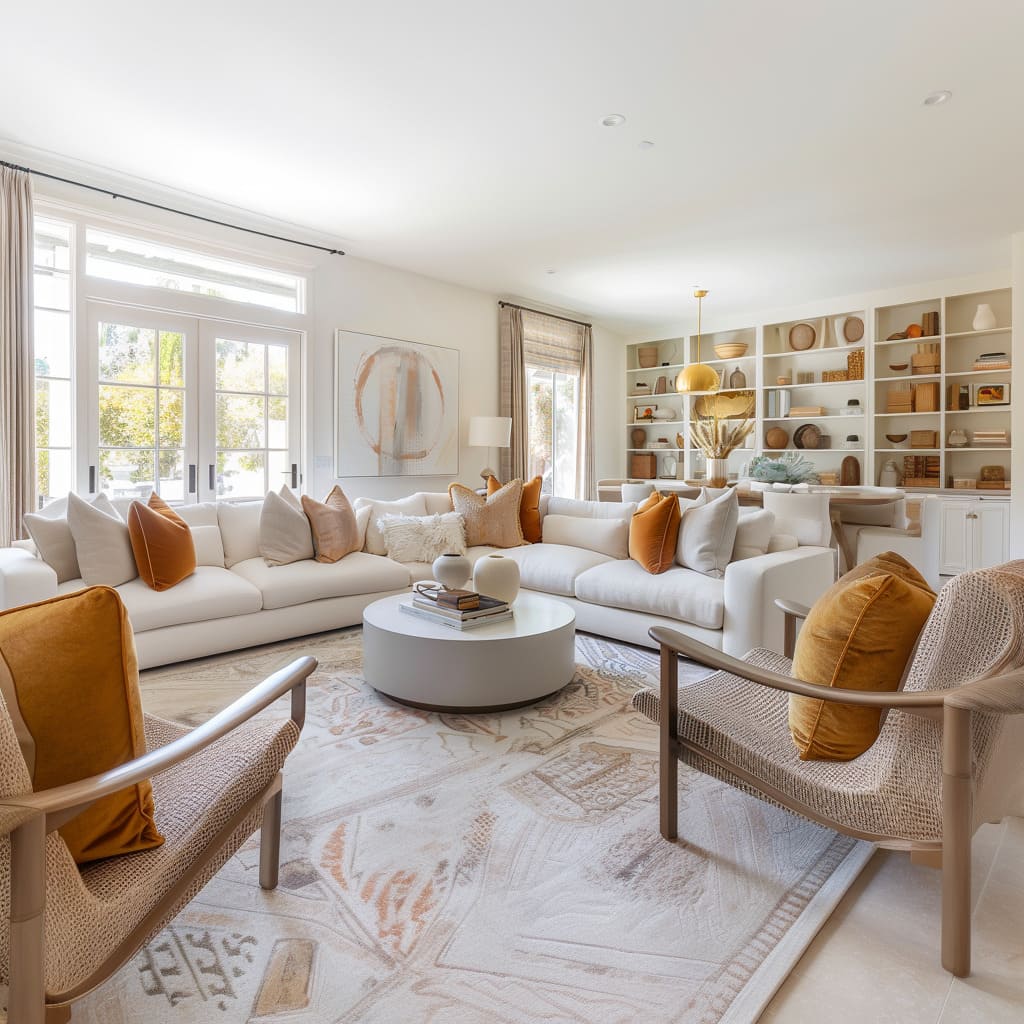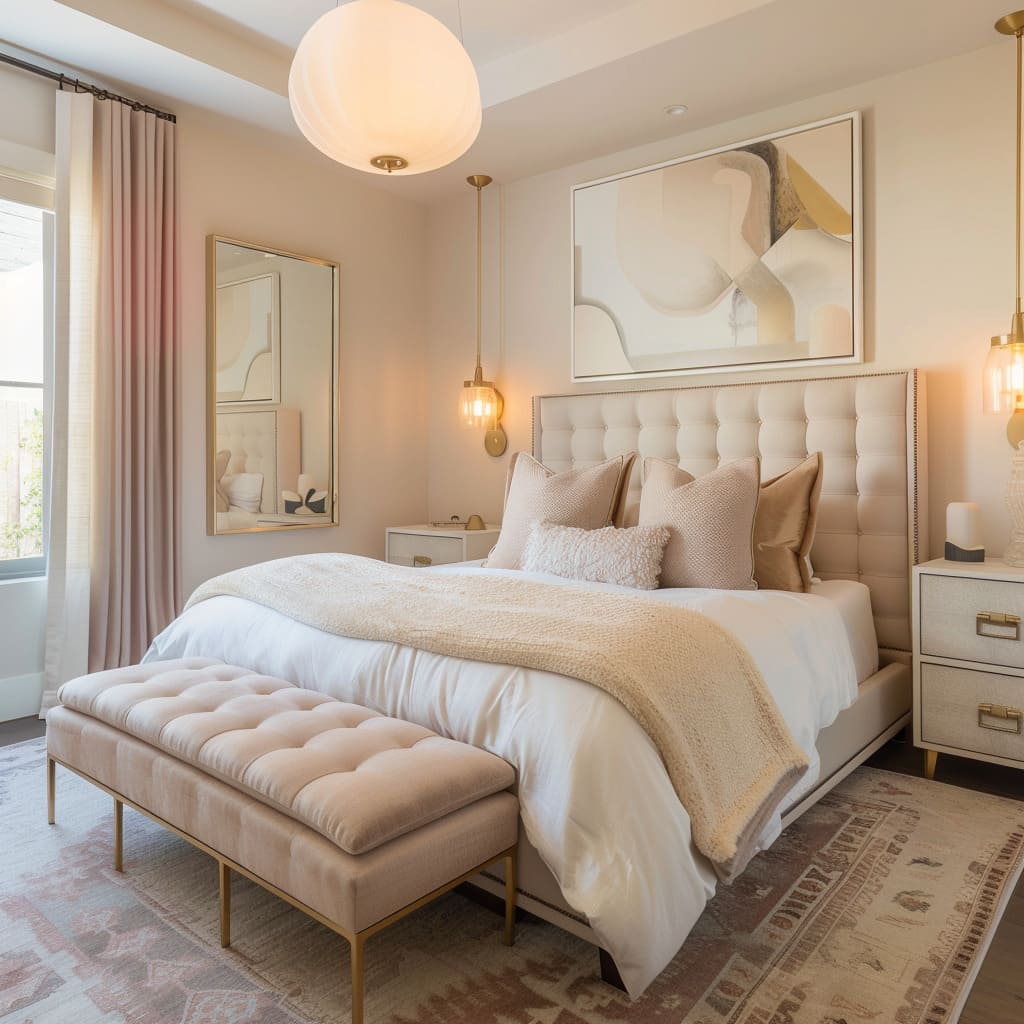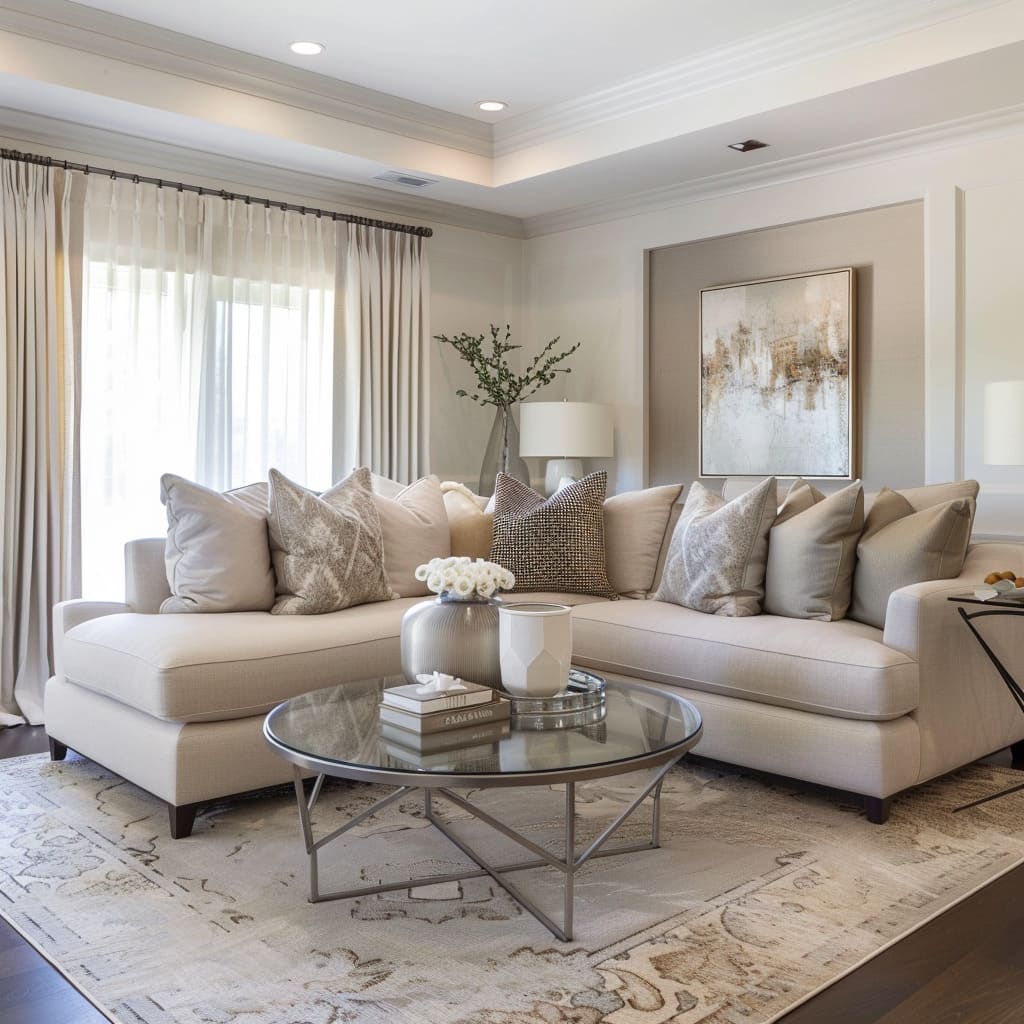Transitional design is a term that evokes a seamless blend of classic and contemporary elements to create spaces that are timeless, elegant, and incredibly versatile. Rooted in the balance between comfort and chic, Transitional-style interiors are like a dialogue between generations of design, where the warmth of traditional aesthetics meets the simplicity of modern design.
At its core, Transitional design is about finding the middle ground. It’s a style that refuses to be pigeonholed, straddling the line between the ornate and the Spartan, the richly textured and the smoothly polished.
It’s this interplay of design elements that makes Transitional-style spaces as appealing to a wide audience as they are – they carry the weight of tradition without feeling dated, and the sleekness of modernity without coming across as cold.
One of the key appeals of Transitional design is its versatility. Whether it’s a bungalow, a high-rise apartment, or a sprawling suburban home, this style can adapt and thrive.
Its principles apply to the grand and the intimate, the bold and the subdued. Transitional design can create coherence in a diverse architectural landscape, making it particularly well-suited for the eclectic mix of living spaces found in a city like Los Angeles.
But how does one create a Transitional space? It begins with an understanding of balance and proportion. These are the invisible threads that hold the design together, ensuring that neither the traditional nor the contemporary elements overwhelm the other.
It’s about creating harmony through contrast – a high-back, tufted sofa paired with a sleek, minimalist coffee table, for instance, or antique brass fixtures illuminating clean, unadorned walls.
When it comes to furniture, Transitional design plays it smart with selections that epitomize both comfort and style. Key pieces in the living room, such as a plush sectional sofa or a pair of wingback chairs, are chosen for their classic silhouettes and then upholstered in modern fabrics for a contemporary twist.
Accent chairs might feature a geometric pattern, but in muted tones that tie back into the room’s neutral base. The color palette in Transitional design is typically understated, relying heavily on neutrals to create a calming backdrop that lets the room’s textures and silhouettes shine.
But this doesn’t mean shying away from color entirely. Strategic pops of color can be introduced through artwork, throw pillows, or accent furniture, adding layers of interest without disturbing the room’s serene atmosphere.
Materials play a crucial role in achieving the Transitional look. A blend of wood, glass, metal, and fabric can be used to create a space that feels grounded yet airy.
The key is to select materials that can speak to both ends of the design spectrum – a polished marble countertop against a backdrop of rustic, reclaimed wood, for instance, or sleek stainless steel appliances nestled within a kitchen of warm, hand-painted cabinetry.
Fabrics and textiles add depth and comfort to Transitional spaces. They are the layers that invite touch and offer warmth.
In a Transitional living room, one might find a variety of textures from the smooth, cool touch of leather to the nubby warmth of a woven throw. The fabrics are often in neutral tones, but varied in texture to keep the eye moving and the space dynamic.
Lighting is another element where the balance of form and function is paramount. In Transitional interiors, lighting fixtures serve as both sources of illumination and sculptural artworks.
Recessed lighting might provide the ambient base, while a carefully selected statement chandelier or a series of pendant lights add focus and style. Table lamps with clean lines and neutral shades can offer warmth and a more intimate scale of light.
Every Transitional space is anchored by architectural details that add character without overpowering. Coved ceilings can lend a soft, traditional touch, while built-in shelving adds a modern convenience and opportunity for personalization.
These architectural elements act as the canvas upon which the Transitional style is painted, allowing for a range of creative expression within a structured framework. This introduction to Transitional design reveals a style that is both adaptable and timeless, a perfect fit for the modern dweller who appreciates the past while looking forward to the future.
As we delve deeper into the specifics of creating a Transitional space, we’ll explore more about how to select the right furnishings, colors, and materials to achieve this balanced and beautiful design style.
Transitional design’s inherent adaptability doesn’t stop with architectural settings; it extends into the living areas, creating a seamless flow between spaces. This is particularly advantageous in open floor plans, where the living room may transition into the dining area or kitchen without walls to define separate rooms.
In these spaces, Transitional design advocates for furniture and decor that carry a cohesive theme, creating visual links that tie the areas together. For instance, a dining table in a dark wood finish might echo the deep tones of a living room’s accent beams, or the fabric of the dining chairs might reflect the texture of the living room’s upholstery.
Strategically placed area rugs can help define different zones within an open-plan space while maintaining an open, airy feel. A rug under the dining table sets it apart from the living area, even as the color and pattern of the rug support the room’s overall design scheme.
Similarly, a rug in the living area can anchor the seating arrangement, providing a soft counterpart to the hard surfaces of kitchen fixtures. This brings us to the integral topic of color and materials.
Transitional spaces often employ a neutral color scheme, but this isn’t to say they lack sophistication or nuance. On the contrary, the subtle use of shades and tones can create a complex visual landscape.
A wall painted in a soft dove gray can serve as a backdrop to a richer slate sofa, with throw pillows in an array of grays and creams adding layers of visual warmth and comfort. The occasional introduction of a bold color, like a deep navy or a rich burgundy, can act as a focal point without upsetting the room’s calm equilibrium.
The material palette in Transitional design is equally thoughtful. A blend of textures—smooth leather, plush velvet, rough-hewn wood, and sleek metal—adds depth and interest.
The trick is to maintain a balance, so no single texture or material dominates. A leather armchair might be paired with a velvet ottoman, or a wooden coffee table might be accented with metal hardware.
The interplay of these elements speaks to the fusion of old and new that defines Transitional style. In the realm of textiles and fabrics, Transitional design places a strong emphasis on quality and comfort.
Drapery in heavy, luxurious fabrics can frame windows without looking fussy, especially when hung from simple, modern hardware. Throw pillows in a mix of textures but a unified color palette add visual and tactile interest to sofas and chairs.
Here, the mix-and-match approach can be applied with restraint, ensuring the space feels curated rather than chaotic.
When it comes to lighting, Transitional interiors often combine overhead ambient lighting with task and accent lighting to create a layered effect. A classic chandelier with a contemporary twist can serve as a stunning centerpiece in a living room, while sleek, modern floor lamps provide focused light for reading or conversation areas.
Table lamps with sculptural forms and neutral shades can add an artistic touch to end tables and nightstands. Architectural details in a Transitional home might include elements such as wainscoting or crown molding, which provide traditional charm.
These features can be modernized through color or scale—for example, painting wainscoting in a glossy white to match the trim, or using a larger, simpler profile for crown molding to give it a more contemporary feel. Built-in shelving and cabinetry offer practical storage solutions while also serving as an opportunity to display curated collections that reflect personal style.
The flooring choices in a Transitional home are crucial to the overall design. Hardwood floors are a popular choice for their timeless appeal and the warmth they bring to a space.
They can be modernized with a cooler stain or a wider plank size. In areas where comfort is key, such as a bedroom or living room, area rugs in soft textures or subtle patterns can add comfort underfoot and help define separate areas within an open layout.
Window treatments in a Transitional design scheme are as much about aesthetics as they are about function. Curtains and blinds can control light and provide privacy, but they also contribute to the room’s design.
Layering sheer and opaque fabrics can add depth and allow for control over natural light throughout the day. The use of motorized window treatments can introduce a modern convenience into the design, blending traditional forms with contemporary functionality.
Lastly, accessorizing a Transitional space is about finding the balance between decoration and simplicity. Decorative elements should complement the design without overwhelming it.
A few carefully chosen vases, books, and sculptures can add personality to a room. The selection of wall art is particularly important—it should reflect the room’s color scheme and contribute to the desired atmosphere without becoming a distraction.
These paragraphs delve further into the practicalities of creating a Transitional space, emphasizing the importance of balance in every design decision. From the planning stage to the final touches, maintaining harmony between classic elegance and modern simplicity is key to achieving the Transitional aesthetic.
As we continue, we’ll explore how to bring nature indoors and the unique features that make Transitional design special, particularly in the sun-soaked environs of Los Angeles.
Let’s turn our attention to the integration of natural elements. Bringing the outdoors inside is more than a mere aesthetic choice; it’s a nod to the human need to connect with nature.
In a Transitional home, the inclusion of indoor plants is more than decorative—it’s a statement of life and growth. A tall fiddle leaf fig tree can add architectural interest to a corner, while a series of potted herbs in the kitchen can be both ornamental and functional.
The greenery not only injects color into the neutral palette but also purifies the air, creating a healthier living environment. Nature’s influence doesn’t stop with plants.
Natural light plays a pivotal role in the ambiance of a Transitional space. Large windows that let in abundant daylight can be framed with light-filtering curtains, which allow for brightness control throughout the day.
The strategic use of mirrors can enhance natural light, reflecting it into less illuminated corners and creating a sense of spaciousness. The special features that define Transitional design, especially in Los Angeles homes, are those that embrace the city’s indoor-outdoor lifestyle.
Large sliding or folding doors that open to patios and gardens blur the line between interior and exterior spaces. Outdoor elements like water features or fire pits become extensions of the living area, visible from inside and adding to the overall sensory experience.
Material choices in Transitional design are deliberate and thoughtful, contributing to the style’s distinctive look. For countertops, a honed finish on stone can offer a matte surface that contrasts beautifully with polished metal fixtures.
Flooring might feature reclaimed wood, lending a sense of history and texture to the space. In the bathroom, a freestanding tub can serve as a modern sculpture, while classic marble tiles provide a timeless backdrop.
Color remains a defining aspect of the Transitional palette. While the foundation is neutral, the inclusion of rich hues in accessories or artwork adds depth and personality.
A velvet throw in a deep emerald green or a set of navy blue vases can act as jewels in the room, drawing the eye and enlivening the space.
The arrangement of furniture in a Transitional home is as much about function as it is about form. Seating should encourage conversation, with chairs and sofas arranged in a way that invites social interaction.
The use of multifunctional pieces, like ottomans that can serve as coffee tables or extra seating, reflects the practical side of Transitional design. Decor in a Transitional space is curated with precision.
Each piece, whether it’s a brass sculpture or a hand-blown glass vase, is selected for its ability to complement the room’s design. The decor should feel collected over time, not purchased in a single shopping trip.
This approach ensures that the space feels authentic and personal.
Fabrics in a Transitional home play with texture to add visual interest. A linen sofa, a woolen rug, and silk pillows can coexist harmoniously when chosen in coordinating colors.
The tactile variety encourages touch and adds a sense of luxury to the space.
Lighting in a Transitional space is layered, creating different moods for different times of day. Dimmer switches can adjust the brightness of overhead fixtures, while table and floor lamps can direct light where it’s most needed.
The fixtures themselves are chosen for their design appeal, with shapes and materials that reflect both past and present.
As we conclude this segment of our exploration into Transitional design, we see that it’s a style marked by a careful balancing act. It respects the past while embracing the present, it finds elegance in simplicity, and it always seeks to create a home that is both stylish and welcoming.
In the next section, we’ll look at how to personalize a Transitional space while honoring its design principles, and how to make smart choices for those finishing touches that make a house a home.
In the art of personalizing a Transitional space, the key lies in the details that reflect individual stories and tastes. While adhering to the Transitional principles of balanced design, homeowners are encouraged to infuse their personality through unique artifacts, family heirlooms, or contemporary art pieces.
This personal touch ensures that the space not only looks like a page from a design magazine but also resonates with the individuality of its inhabitants.
Transitional interiors often showcase a blend of cultural influences. A Persian rug underfoot, an abstract painting from a local artist, or pottery collected from travels—each element contributes to the narrative of the home.
These pieces stand out against the neutral backdrop of a Transitional palette, telling their stories without clashing with the cohesive design scheme.
Furniture arrangement in Transitional design is about creating a dialogue between pieces from different eras. A contemporary sofa may face a pair of vintage armchairs, fostering a conversation between styles.
The arrangement is purposeful, not just to facilitate flow and function, but also to highlight the furniture’s design lines, whether they be the ornate curves of a classic piece or the sleek edges of a modern one.
Decor in a Transitional space should be both purposeful and restrained. The decor is not merely about filling space but rather about enhancing it.
A minimalistic approach ensures that each piece—from a brass candlestick to a ceramic bowl—stands out as an individual statement, contributing to the room’s layered sophistication.
In the world of fabrics and textiles, Transitional design favors a blend of practicality and indulgence. Durable materials like leather for seating can coexist with luxurious velvet curtains.
The juxtaposition of such materials adds a dynamic sense to the space, where functionality meets elegance, ensuring that the interiors are not only beautiful to look at but also comfortable to live in.
When it comes to selecting those all-important finishing touches, Transitional design holds craftsmanship in high regard. A hand-carved wooden side table or a handwoven throw can add a layer of artisanal quality that mass-produced items cannot match.
These touches of craftsmanship help to ground the space, reminding us of the human hand and the time-honored skills behind some of our everyday surroundings.
The choice of color and texture in a Transitional home can be both strategic and playful. A statement wall in a bold color can act as a focal point, while textured wallpapers can add depth and intrigue.
The key is to maintain the space’s overall sense of calm and cohesion, using color and texture to enhance rather than overwhelm.
Lighting fixtures, often the jewelry of the room, are selected for their ability to complement both the functional and aesthetic needs of the space. A vintage lamp can add character, while a modern sculptural piece can serve as a conversation starter.
The interplay of light and shadow can be used to highlight architectural features and create ambiance.
Embracing outdoor living is a special feature of Los Angeles-inspired Transitional design. Outdoor spaces are treated as extensions of the interior, with furniture, fabrics, and decor chosen to withstand the elements while still maintaining the elegance of the indoors.
This seamless transition between inside and outside underscores the laid-back yet sophisticated lifestyle that is quintessential to Southern California.
In conclusion, Transitional design is a celebration of balance, a dance between the old and the new. It is a style that honors the bones of classic design while dressing them in the sleek attire of modernity.
It is both a nod to history and a step towards the future, creating spaces that are not just houses but homes—comfortable, elegant, and timeless. As we reflect on the principles of Transitional design, we are reminded that the ultimate goal is to create a space that feels harmonious, welcoming, and uniquely ours.







































